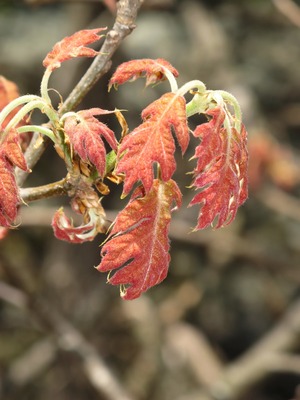Posted by Doug Struck January 14, 2014 10:19 PM
By Doug Struck
Globe Correspondent
Buried in rows and columns of meticulous notations of 160 years ago, clues left by Henry David Thoreau point to a war of woods in the changing climate that may leave New England forests looking far different than today.
Thoreau’s frenetic notes made as he “sauntered” around Walden Woods already have demonstrated that plants are flowering much earlier than in the mid-1800s.
But now researchers at Boston University have pored through other overlooked  records from the Concord naturalist. They have used the handwritten data to show that native trees are the underdogs in a struggle with invasive species as the climate warms.
records from the Concord naturalist. They have used the handwritten data to show that native trees are the underdogs in a struggle with invasive species as the climate warms.
“The forests will be different,” said Richard Primack, a professor of biology at Boston University. “As the climate begins to warm, and we get ever-milder winters and earlier springs, invasive shrubs and trees are poised to take advantage of the situation.
“Within a half a century– certainly by end of the century– we will see a lot of die-offs of our native species,” he said.
Primack and a changing cast of students have been comparing the observations in Thoreau’s diaries with the present conditions at Walden Woods for seven years. They have demonstrated that common flowers now bloom earlier, many species have disappeared, and the shift in plant cycles is disrupting bird migration rhythms.
But just as the scientists thought the research was playing out, Thoreau scholars mentioned yet another trove of his observations were being kept at the Morgan Library and Museum in New York, a collection that started with the private library of tycoon J.P. Morgan and now keeps priceless original manuscripts.
Caroline Polgar, a doctoral candidate working with Primack, went to Manhattan and found what she describes as “basically an Excel spreadsheet,” in bad handwriting, written on surveyor’s sheets. Thoreau worked occasionally as a surveyor, and apparently extracted data from his journals to be arranged in comprehensive tables on spare sheets, with columns covering 1852 to 1860.
“It was a little surreal handling such rare documents,” Polgar said. “It was really hard to read. His handwriting was not very good. Sometimes he used common names, and sometimes he used Latin names. We had to go back and figure out what species he was talking about.”
They found that species now go through “leaf out”—the moment when the blades poke from swollen buds—an average of 18 days earlier now than in Thoreau’s day. That confirmed their earlier work with flowers.
But the researchers took that finding a step further. They brought twigs from different species into a warm lab at different times of the winter, to see how quickly the wood awoke from winter dormancy and began to produce leaves. Some species native to New England require a long winter chill before reawakening in spring, and responded slowly.
“We saw there was a huge difference between species,” Primack said. “These invasive species have a minimal chilling requirement. They really didn’t have to go to sleep much in the winter. And they reacted very quickly to warm temperatures; they woke up very fast, within a week or two. Native trees– maple, white oak, and native shrubs– generally needed a very long winter time before they started to leaf out.”
That restless winter slumber and fast-start growth will give invasive species a big advantage in a warmer climate, concluded Primack, Polgar and her fellow grad student Amanda Gallinat, who co-authored the paper in the journal New Phytologist. Primack predicts fewer beech and ash trees and native sugar, red and silver maples, while non-native Norway Maples and hardy native oaks, which can withstand summer heat, will flourish.
These findings are particularly valuable, Primack said, because they can show the likely consequences of climate change elsewhere. Nationally, average temperatures have risen about 1.5 degrees Fahrenheit. But the burgeoning metropolitan area around Boston has caused an “urban heat island”– more hot streets, roofs and parking lots, less green space—so temperatures even as far out as Concord have gone up more than 4 degrees Fahrenheit since 1860.
“Boston serves as a model system for how climate change will affect the rest of the United States,” he said. “Boston has had as much warming in the last 160 years as the rest of the country is expected to have in this century. Because we have had a huge change of temperature, you can see the effects of global warming.”
And, he noted, there are the prolific notes of Thoreau–and others– to provide unique historical records.
“Boston has this incredible wealth of historical data that really hasn’t been found in the rest of the country,” Primack said. “Boston has an unusual density of naturalists who keep diaries, bird clubs, butterfly clubs, botanical clubs… We just keep discovering more data sets. We just keep finding interesting things.”
(Photo: New Black Oak leaves. courtesy of Boston University)